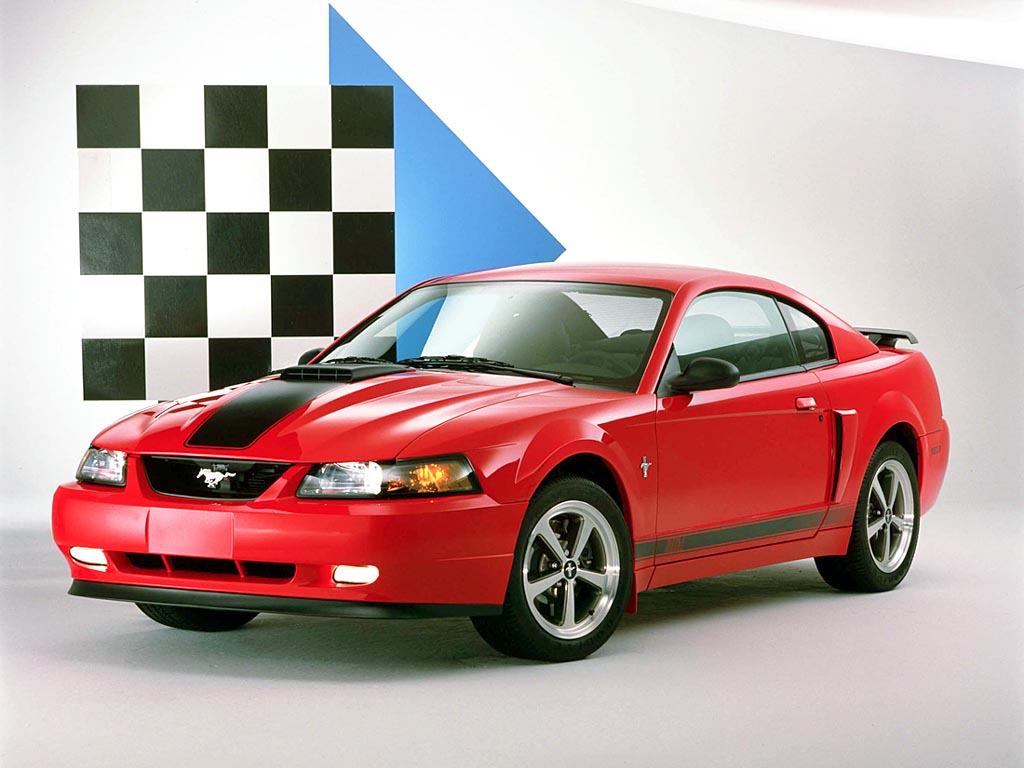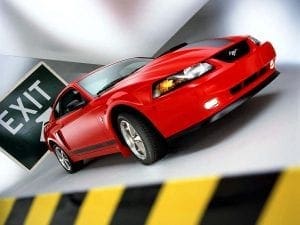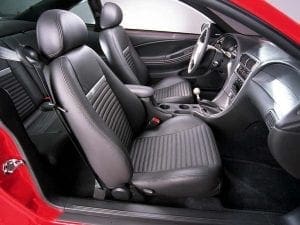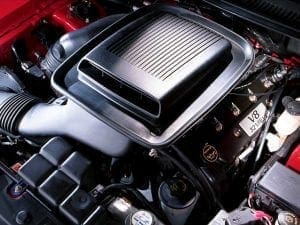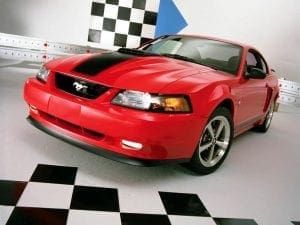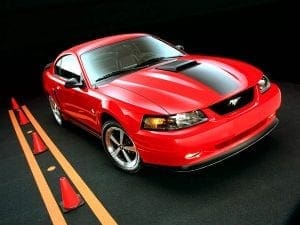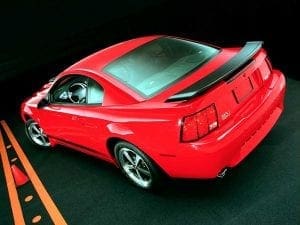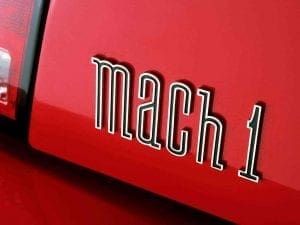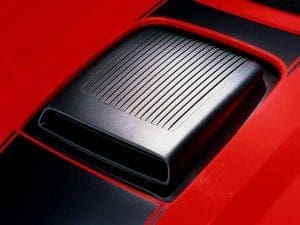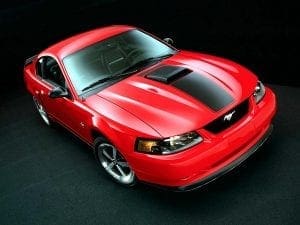2003 Ford Mustang Mach 1
With the success of the 2001 Mustang Bullitt, Ford once again wanted to cash in on the popularity of a retro inspired Mustang. Heritage was big back in 2003, especially at the Ford Motor Company who was celebrating a century of car building that year. This time however, instead of creating a new model with a retro feel the people at Ford decided to revive an old friend from the past. The Mustang name oozed heritage and Ford was more than willing to look into the past to bring some new sizzle to the Mustang line. With the introduction of the supercharged 390-horsepower Cobra for 2003 Ford had plenty of room in the line up to slot a new vehicle between the Cobra and the 260-horsepower GT.
So for 2003, Ford resurrected Mach 1. Equipped with appropriate decals and a shaker hood. This is a performance car from the past. Many older Mustang fans (myself included) are very familiar with the Mach 1 and its performance history.
The Mach 1 has 305 hp and 320 lb-ft of torque. Its equipped with a shaker hood, a unique gauge cluster, a 305 hp V8 with Multi-port fuel injection a 5 speed transmission and 17 ” wheels styled after the original wheels.
The gauge cluster consists of two large easy to read center 360 degree gauges. The speedometer is a 0-150 MPH black with white lettering. The tachometer mounted to the right of the speedometer shows 0-8000 RPM and a easy to read redline at 6000 RPM. Flanking the main two center gauges are a fuel gauge and temperature gauge on the left and a Amp and oil pressure gauge on the right.
Perhaps the most visually arresting design cue on the Mach 1 is the shaker scoop. But in keeping with performance Mustang heritage, the scoop is not only for appearance, but functional. The ram-air scoop channels fresh air directly to the intake runners increasing the breathing and optimizing intake turbulence for improved power and torque.
Mach 1’s suspension matches its power with crisp road manners. The vehicle is lowered one-half of an inch compared to the GT and uses a firmer suspension for better-balanced ride and improved handling characteristics. Because the chassis tuning that was used on the Bullitt was such a success, Ford pretty much equipped the Mach 1 with the same modifications. With the improved brakes, suspension and rigidity with the additional subframe connectors the Mach 1 could out perform the lesser GT not only on the drag strip but also through the corners.
The Mach 1 from the late 60’s and early 70’s was a hallowed car among Mustang enthusiasts and Ford wanted to make a tribute car that had some substance to go along with the interior and exterior styling cues. They wanted to bring back the tire shredding performance that the Mach 1’s from the early days were known for, and Ford delivered the performance in a big way.
Under the hood Ford tossed out the 4.6-litre two-valve V-8 engine from the GT in favor of a 32-valve twin-cam. Now you can be forgiven if you think that the Mach 1’s 32-valve engine is simply the mill lifted out of the 2001 Cobra since these two engines share some similarities; however the 32-valver in the Mach 1 is a unique engine to the Mach 1. For starters the aluminum engine block used for the Mach 1 was sourced from the Windsor Aluminum Plant (WAP) rather than the Teksid aluminum blocks used in the 1996-1999 Cobras. The Windsor engine block only weighed 80-pounds, 5-pounds less than the Teksid block. For added rigidity the WAP block featured more external ribbing and revised main bearing webs internally. Engineers also reduced engine noise by employing a thicker pan rail.
Inside the engine, manually shifted Mach 1’s employed a forged steel crankshaft while slush-box equipped cars used a cast crankshaft. While both versions of the engine had the same horsepower ratings the automatic cars were limited to 5,800-rpm while the manual transmission Mach 1’s had a dizzying 6,800-rpm redline. These changes were deemed necessary in order to keep the automatic transmission from prematurely failing.
Bolted to the block were revised cylinder heads sourced from the 2003 Cobra. These new heads featured a high flow design and rerouted water passages. To get the most out of the new high flow heads engineers pilfered the camshafts from the 5.4-litre Lincoln InTech DOHC V-8. These cams provided the Mach 1 with more mid-range torque versus the 2001 engine in the Cobra. Along with the revised heads Ford also bumped up the compression ratio from 9.85:1 for the 2001 Cobra to 10.1:1 for the Mach 1. Bolted to the heads were reworked free-flow exhaust manifolds that were port-matched to the heads and a unique intake manifold with a cold air shaker scoop that poked up through the hood.
Horsepower for the 2003 and 2004 Mach 1 was rated at 305-horsepower and 320-pound-feet of torque. While horsepower was down slightly from the 2001 Cobra, torque on the other hand was up and the engine produced its peek power at lower engine speeds allowing the Mach 1 to be a better performing vehicle in most driving situations. It also allowed the driver to punish the pavement with some colossal smokey tire burnouts with relative ease, just like big block Mach 1’s did back in the late 60’s.
When tested the 2003 Mach 1 with a manual transmission could hit 60-miles an hour in just 5.2 seconds and could dash through a 600-foot slalom at 63.5 miles-an-hour and produce .85 g’s of grip on a skid pad; very respectable for any vehicle at the time, especially one based on nearly quarter century old design. And with pricing pegged between the GT and Cobra the Mach 1 was an outstanding value!
Ford produced 9,652 Mach 1’s in 2003. For a full split and details of the 2003 Mach 1 production numbers check out our in-depth post.
Pictures
Specifications
| Model & Year | 2003 Mustang Mach 1 |
| built at | Detroit, Michigan, USA |
| engine | MOD V8 |
| position | Front Longitudinal |
| valvetrain | DOHC |
| displacement | 4605 cc / 281.0 in³ |
| bore | 90.2 mm / 3.55 in |
| stroke | 90 mm / 3.54 in |
| compression | 10.1:1 |
| power | 223.7 kw / 300.0 bhp @ 6000 rpm |
| specific output | 65.15 bhp per litre |
| bhp/weight | bhp per tonne |
| torque | 406.75 nm / 300.0 ft lbs @ 4250 rpm |
| body / frame | Unit Steel |
| driven wheels | RWD |
| front tires | Goodyear 245/45ZR17 Eagle ZR45 |
| rear tires | Goodyear 245/45ZR17 Eagle ZR45 |
| front brakes | Brembo Vented Discs w/2-Pot Calipers, |
| f brake size | x 330 mm / x 13.0 in |
| rear brakes | Brembo Vented Discs w/Single-Pot Calipers, |
| r brake size | x 296 mm / x 11.7 in |
| front wheels | F 43.2 x 20.3 cm / 17.0 x 8.0 in |
| rear wheels | R 43.2 x 20.3 cm / 17.0 x 8.0 in |
| steering | Rack & Pinion w/Power Assist |
| f suspension | MacPherson Strut w/Spring on Lower Arm, Coil, Axle Damper,26.5 A |
| r suspension | 4-Link Multi-Link w/Coil Springs on Lower Arm, Axel Damper,23mm |
| curb weight | 1572 kg / 3466 lbs |
| wheelbase | 2573 mm / 101.3 in |
| front track | 1529 mm / 60.2 in |
| rear track | 1539 mm / 60.6 in |
| length | 4653 mm / 183.2 in |
| width | 1856 mm / 73.1 in |
| height | 1329 mm / 52.3 in |
| transmission | 5-Speed Manual or 4-Speed Automatic |
| gear ratios | 3.38:1, 2.00:1, 1.32:1, 1.00:1, 0.62:1, :1 |
| final drive | 3.55:1 |


